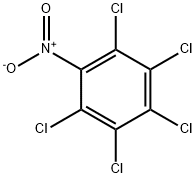-
Name
Quintozine
- EINECS 201-435-0
- CAS No. 82-68-8
- Article Data37
- CAS DataBase
- Density 1.718
- Solubility insoluble soluble in carbon disulfide, benzene, chloroform and chlorinated hydrocarbons; slightly soluble in ethanol.
- Melting Point 142 - 146 C
- Formula C6Cl5 N O2
- Boiling Point 328 C (decompose)
- Molecular Weight 295.337
- Flash Point 11°C
- Transport Information 40kgs
- Appearance white to pale yellow solid
- Safety Moderately toxic by ingestion. An experimental teratogen. Questionable carcinogen with experimental carcinogenic data. Mutation data reported. Used as a fungicide. Dangerous; when heated to decomposition it emits highly toxic fumes of NOx and Cl−. See also NITRO COMPOUNDS of AROMATIC HYDROCARBONS.
- Risk Codes R43;R50/53
-
Molecular Structure
- Hazard Symbols Skin irritant. TLV: TWA 0.5 mg/m3; Not Classifiable as a Human Carcinogen
- Synonyms Benzene,pentachloronitro- (8CI,9CI); 1,2,3,4,5-Pentachloronitrobenzene;2,3,4,5,6-Pentachloronitrobenzene; Avicol (pesticide); Batrilex; Botrilex;Brassicol; Brassicol 75; Brassicol Super; Chinozan; Fartox; Folosan; Fomac 2;GC 3944-3-4; Kobutol; Korsikol; Marisan forte; NSC 58427;Nitropentachlorobenzene; PCNB; Pentachloronitrobenzene; Pentagen; Phomasan;Plantacol; Quinosan; Quintozen; Quintozene; RTU 1010; RTU PCNB; Terrachlor;Terraclor; Terraclor 30G; Terrafun; Terrazan; Terrazan F; Tilcarex; Tritisan
- PSA 45.82000
- LogP 5.38500
Quintozine Chemical Properties
IUPAC Name: 1,2,3,4,5-Pentachloro-6-nitrobenzene
CAS: 82-68-8
Formula: C6Cl5NO2
Molecular Weight: 295.33
Molecular Structure of 1,2,3,4,5-Pentachloro-6-nitrobenzene (CAS NO.82-68-8):

Density: 1.834 g/cm3
Flash Point: 161.6 °C
Melting Point: 140-143 °C(lit.)
Boiling Point: 328 °C at 760 mmHg
Index of Refraction: 1.629
Molar Refractivity: 57.27 cm3
Molar Volume: 161 cm3
Polarizability: 22.7×10-24cm3
Surface Tension: 56.8 dyne/cm
Enthalpy of Vaporization: 54.77 kJ/mol
Vapour Pressure: 0.000372 mmHg at 25°C
Water Solubility: 0.5804(mg/L) at 25°C
Appearance: Light green powder
Product Categories: method 8081Volatiles/ semivolatiles;500 series drinking water methods;8000 series solidwaste methods;alpha sort;EPA;method 508EPA;P-SAlphabetic;alphabetic;P;PA - PEN.
Quintozine Toxicity Data With Reference
| 1. | dnd-esc 20 µmol/L | MUREAV Mutation Research. 89 (1981),95. | ||
| 2. | mrc-asn 40 µmol/L | MUREAV Mutation Research. 147 (1985),288. | ||
| 3. | orl-rat LD50:1100 mg/kg | FAATDF Fundamental and Applied Toxicology. 7 (1986),299. | ||
| 4. | ihl-rat LC50:1400 mg/m3 | 85GMAT Toxicometric Parameters of Industrial Toxic Chemicals Under Single Exposure Izmerov, N.F., et al.,Moscow, USSR.: Centre of International Projects, GKNT,1982,96. | ||
| 5. | skn-rat LD50:4 g/kg | FMCHA2 Farm Chemicals Handbook .(Meister Publishing,Willoughy, OH.: )1989,C221. | ||
| 6. | orl-mus LC50:1400 mg/kg | 85GMAT Toxicometric Parameters of Industrial Toxic Chemicals Under Single Exposure Izmerov, N.F., et al.,Moscow, USSR.: Centre of International Projects, GKNT,1982,96. | ||
| 7. | ihl-mus LC50:2 g/m3 | 85GMAT Toxicometric Parameters of Industrial Toxic Chemicals Under Single Exposure Izmerov, N.F., et al.,Moscow, USSR.: Centre of International Projects, GKNT,1982,96. | ||
| 8. | ipr-mus LD50:4500 mg/kg | ARTODN Archives of Toxicology. 51 (1982),329. |
Quintozine Consensus Reports
IARC Cancer Review: Group 3 IMEMDT IARC Monographs on the Evaluation of Carcinogenic Risk of Chemicals to Man . 7 ,1987,p. 56.(World Health Organization, Internation Agency for Research on Cancer,Lyon, France.: ) (Single copies can be ordered from WHO Publications Centre U.S.A., 49 Sheridan Avenue, Albany, NY 12210) ; Animal Sufficient Evidence IMEMDT IARC Monographs on the Evaluation of Carcinogenic Risk of Chemicals to Man . 5 ,1974,p. 211.(World Health Organization, Internation Agency for Research on Cancer,Lyon, France.: ) (Single copies can be ordered from WHO Publications Centre U.S.A., 49 Sheridan Avenue, Albany, NY 12210) . NCI Carcinogenesis Bioassay (feed); No Evidence: mouse, rat NCITR* National Cancer Institute Carcinogenesis Technical Report Series. (Bethesda, MD 20014) No. NCI-CG-TR-61 ,1978. . Reported in EPA TSCA Inventory. EPA Genetic Toxicology Program.
Quintozine Safety Profile
Moderately toxic by ingestion. An experimental teratogen. Questionable carcinogen with experimental carcinogenic data. Mutation data reported. Used as a fungicide. Dangerous; when heated to decomposition it emits highly toxic fumes of NOx and Cl−. See also NITRO COMPOUNDS of AROMATIC HYDROCARBONS.
Safety Information about 1,2,3,4,5-Pentachloro-6-nitrobenzene (CAS NO.82-68-8):
Hazard Codes:
Xi:
Xn:  N:
N:  T:
T:  F:
F: 
Risk Statements about 1,2,3,4,5-Pentachloro-6-nitrobenzene (CAS NO.82-68-8):
R43: May cause sensitization by skin contact.
R50/53: Very Toxic to aquatic organisms, may cause long-term adverse effects in the aquatic environment.
R39/23/24/25: Toxic: danger of very serious irreversible effects through inhalation, in contact with skin and if swallowed.
R23/24/25: Toxic by inhalation, in contact with skin and if swallowed.
R11: Highly Flammable.
R40: Limited evidence of a carcinogenic effect.
Safety Statements about 1,2,3,4,5-Pentachloro-6-nitrobenzene (CAS NO.82-68-8):
S13: Keep away from food, drink and animal feeding stuffs.
S24: Avoid contact with skin.
S37: Wear suitable gloves.
S60: This material and/or its container must be disposed of as hazardous waste.
S61: Avoid release to the environment. Refer to special instructions safety data sheet.
S45: In case of accident or if you feel unwell, seek medical advice immediately (show label where possible).
S36/37: Wear suitable protective clothing and gloves.
RIDADR: UN 3077 9/PG 3
WGK Germany: 2
RTECS: DA6650000
Quintozine Standards and Recommendations
ACGIH TLV: TWA 0.5 mg/m3; Not Classifiable as a Human Carcinogen
Quintozine Specification
The chemical synonyms of 1,2,3,4,5-Pentachloro-6-nitrobenzene (CAS NO.82-68-8) are 101Brandpcnb75wettable ; Ai-23024 ; Avicol ; Avicol(pesticide) ; Avicol, pesticide ; Batrilex ; Benzene,pentachloronitro- ; Botrilex . To stimulate the skin and eyes caused by allergies, there erythema, scabies and edema. It shoud be storaged in cool, dry place, or in water tanks, cold storage room.
About|Contact|Cas|Product Name|Molecular|Country|Encyclopedia
Message|New Cas|MSDS|Service|Advertisement|CAS DataBase|Article Data|Manufacturers | Chemical Catalog
©2008 LookChem.com,License: ICP
NO.:Zhejiang16009103
complaints:service@lookchem.com Desktop View